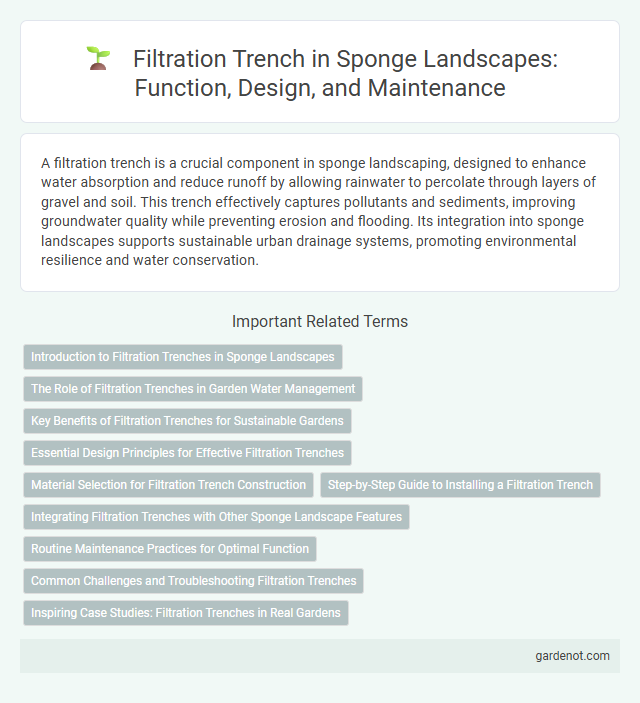A filtration trench is a crucial component in sponge landscaping, designed to enhance water absorption and reduce runoff by allowing rainwater to percolate through layers of gravel and soil. This trench effectively captures pollutants and sediments, improving groundwater quality while preventing erosion and flooding. Its integration into sponge landscapes supports sustainable urban drainage systems, promoting environmental resilience and water conservation.
Introduction to Filtration Trenches in Sponge Landscapes
Filtration trenches in sponge landscapes are specialized structures designed to capture and treat stormwater runoff, enhancing groundwater recharge while reducing pollutants. These trenches typically consist of a gravel-filled trench with an underlying permeable layer, allowing water to percolate slowly into the soil and filter contaminants naturally. Incorporating filtration trenches helps improve urban water management by mitigating flooding and enhancing water quality within green infrastructure systems.
The Role of Filtration Trenches in Garden Water Management
Filtration trenches play a critical role in garden water management by capturing and filtering stormwater runoff, reducing soil erosion, and improving groundwater recharge. These trenches are filled with permeable materials like gravel and sand that trap pollutants and sediments while allowing water to infiltrate slowly into the soil. Incorporating filtration trenches into sponge landscape designs enhances urban resilience by mitigating flooding and promoting sustainable water cycles in green spaces.
Key Benefits of Filtration Trenches for Sustainable Gardens
Filtration trenches enhance sustainable gardens by efficiently managing stormwater runoff, reducing soil erosion, and improving groundwater recharge. These trenches filter pollutants and sediments through layers of gravel and sand, promoting cleaner water percolation. Incorporating filtration trenches supports healthier plant growth and conserves local water resources by minimizing surface water contamination.
Essential Design Principles for Effective Filtration Trenches
Filtration trenches must incorporate permeable soil or gravel layers to maximize stormwater infiltration and pollutant removal efficiently. The trench depth should balance adequate storage capacity with maintaining unsaturated soil conditions to prevent clogging and promote aerobic microbial activity. Vegetative cover or engineered media can enhance filtration by trapping suspended solids while supporting groundwater recharge within sponge landscape systems.
Material Selection for Filtration Trench Construction
Selecting appropriate materials for filtration trench construction within sponge landscapes involves choosing highly permeable, durable substrates like washed gravel and coarse sand to enhance water infiltration and pollutant removal. Incorporating geotextiles prevents soil migration while maintaining hydraulic conductivity, ensuring long-term system efficiency. Proper material gradation and compatibility with local soil conditions optimize groundwater recharge and reduce surface runoff.
Step-by-Step Guide to Installing a Filtration Trench
Excavate a trench approximately 18-24 inches wide and 18 inches deep in the designated sponge landscape area, ensuring proper slope for drainage. Line the trench with geotextile fabric to prevent soil intrusion, then fill the bottom with a 4-6 inch layer of uniformly graded gravel for optimal filtration and water flow. Install perforated PVC pipes centered in the trench, cover with additional gravel up to 6 inches below the surface, and fold the fabric over before backfilling with soil and vegetation to maximize stormwater infiltration.
Integrating Filtration Trenches with Other Sponge Landscape Features
Integrating filtration trenches with rain gardens, permeable pavements, and bioswales enhances stormwater management by optimizing water infiltration and pollutant removal. These interconnected sponge landscape features collectively reduce surface runoff, recharge groundwater, and improve water quality through natural filtration processes. Designing filtration trenches alongside native vegetation further supports soil stabilization and habitat diversity within urban green infrastructure.
Routine Maintenance Practices for Optimal Function
Routine maintenance of filtration trenches involves regular removal of accumulated sediments and debris to prevent clogging and ensure efficient water infiltration. Inspecting trench liners and surrounding vegetation helps maintain structural integrity and hydraulic performance. Periodic flushing or vacuuming restores permeability, promoting effective stormwater management within sponge landscape systems.
Common Challenges and Troubleshooting Filtration Trenches
Filtration trenches often face challenges such as clogging due to sediment accumulation, poor drainage from improper slope design, and limited infiltration capacity in compacted soils. Troubleshooting involves regular maintenance like sediment removal, ensuring appropriate trench sizing based on runoff volumes, and incorporating check dams or perforated pipes to enhance water flow. Addressing soil permeability issues through soil amendments or alternative infiltration methods improves overall trench performance in sponge landscape systems.
Inspiring Case Studies: Filtration Trenches in Real Gardens
Filtration trenches efficiently manage stormwater by filtering pollutants and promoting groundwater recharge in real garden settings. Notable cases demonstrate how these trenches integrate seamlessly with native vegetation, enhancing water quality while supporting local biodiversity. Their strategic placement and design showcase sustainable landscaping that mitigates runoff and prevents soil erosion effectively.
Filtration trench Infographic

 gardenot.com
gardenot.com